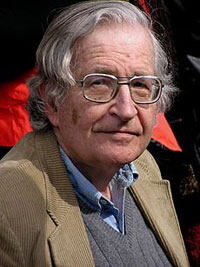Noam Chomsky
Barn December 7, 1928; mathematical linguist who is responsible for the hierarchy of grammars that bears his name; recipient of the 1988 Kyoto Prize in Basic Science.

Chomsky's work on the syntax of languages coincided neatly with the early development of programming languages and thus his work found ready application to the more formal style of artificial language than those of his original interest--natural languages. The recognition of a hierarchy of syntactic forms each properly subsetted inside the next and each representing a particular language style also matched some of the lower levels of programming language elements. The Chomsky hierarchy places regular (or linear) languages as a subset of the context-free languages, which in turn are embedded within the set of context-sensitive languages also finally residing in the set of unrestricted or recursively enumerable languages. By defining syntax as the set of rules that define the spatial relationships between the symbols of a language, various levels of language can be also described as one-dimensional (regular or linear), two-dimensional (context-free), three-dimensional (context sensitive) and multi-dimensional (unrestricted) relationships. From these beginnings, Chomsky might well be described as the "father of formal languages."
Like Edmund Berkeley, Chomsky became embroiled in the peace movements of the 1960s and so divided his efforts between his linguistic studies and his social concerns. His publications since 1960 have been divided between the two subjects.
QUOTATIONS
"The fundamental aim in linguistic analysis of language L is to separate the grammatical sequences which are sentences of L from the ungrammatical sequences which are not sentences of L and to study the structure of grammatical sequences." (1957)
"The notion grammatical cannot be identified with meaningful or significant in any semantic sense. Sentences (1) and (2) are equally nonsensical, but any speaker of English will recognize that only the former is grammatical:
(1) Colorless green ideas sleep furiously.
(2) Furiously sleep ideas green colorless." (1957)
BIBLIOGRAPHY
Biographical
George, Alexander, ed., Reflections on Chomsky, B. Blackwell, Oxford, 1989.
Piattelli-Palmarini, Massimo, ed., Language and Learning: the Debate Between Jean Piaget and Noam Chomsky, Harvard University Press, Cambridge, Mass., 1980.
Significant Publications
Chomsky, Noam, Syntactic Structures, Mouton & Co., The Hague, 1957.
Chomsky, Noam, Chomsky: Selected Readings, Oxford University Press, Oxford, 1971.
Chomsky, Noam, Language and Mind, enl. ed., Harcourt Brace Jovanovich, New York, 1972.
Chomsky, Noam, Topics in the Theory of Generative Grammar, Mouton & Co. The Hague, 1975.
Chomsky, Noam, The Logical Structure of Linguistic Theory, Plenum Press, New York, 1975.
Chomsky, Noam, Reflections on Language, 1st ed., Pantheon Books, New York, 1975.
Chomsky, Noam, Rules and Representations, Columbia University Press, New York, 1980.
Chomsky, Noam, Knowledge of Language: Its Nature, Origin, and Use, Praeger, New York, 1986.
Chomsky, Noam, Language and Problems of Knowledge: the Managua Lectures, MIT Press, Cambridge, Mass., 1988.
UPDATES
Portrait inserted, MRW, 2012.
New content Copyright © 2013-2023 by the IEEE Computer Society and the Institute of Electrical and Electronics Engineers Inc.
All rights reserved. This material may not be reproduced or redistributed without the express written permission of the copyright holder.
